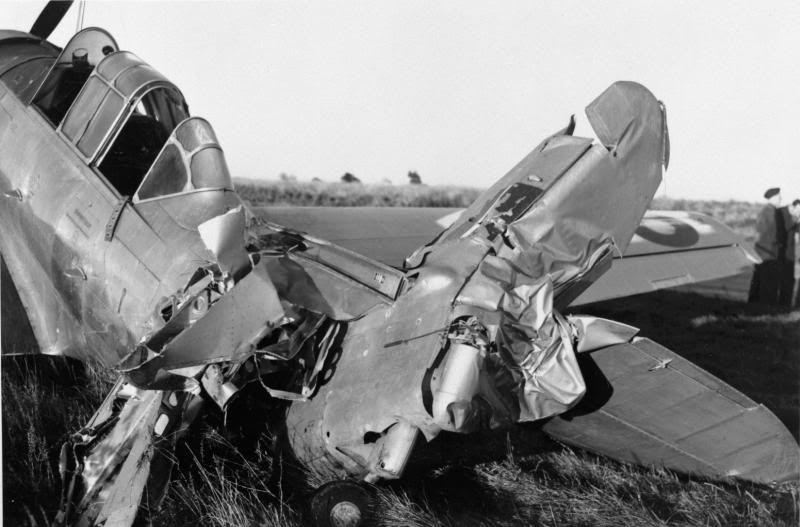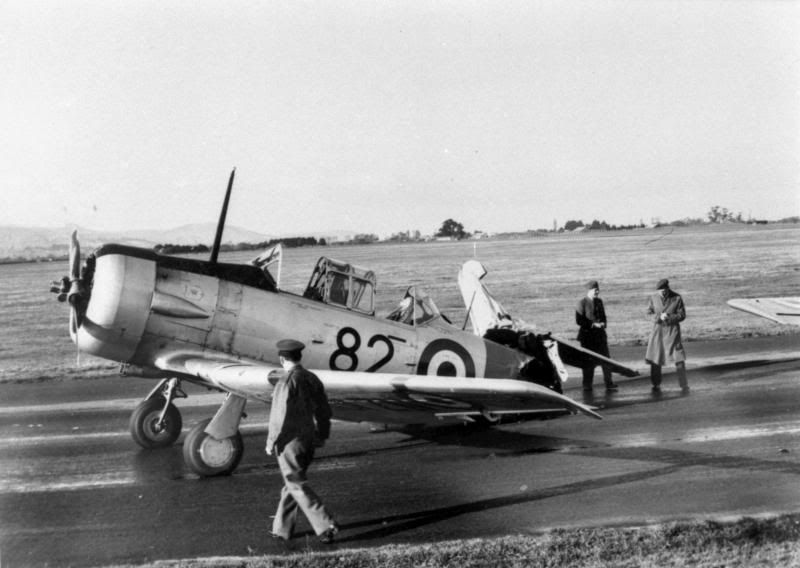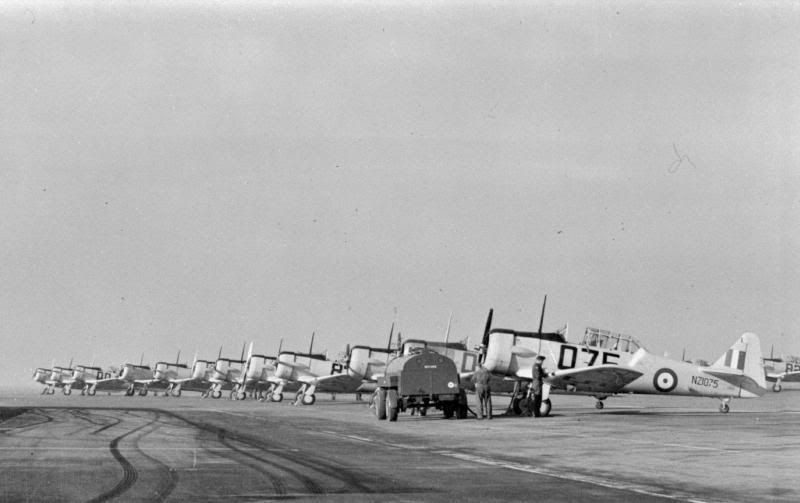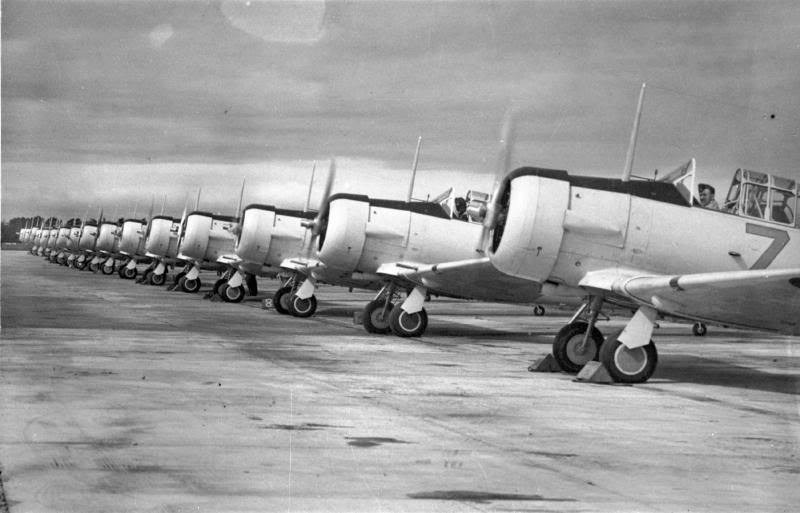|
|
Post by Dave Homewood on May 20, 2014 10:00:48 GMT 12
OK so it does seem to be Lake Grassmere. Thanks all. I wonder if the photo was taken en route from Hobsonville where it was assembled and test flown, to Wigram where it lived. Or if this was later and was on a cross-country from Wigram. Norm Rosser did his training at Woodbourne so he may have either snapped it himself or he picked up the photo locally from there. I guess the camouflaged Harvard next to it is possibly one of those that wore camo and big yellow panels at Woodbourne from 1942. Or it could be a Fairhall based Fighter squadron example.
|
|
|
|
Post by davidd on May 20, 2014 13:57:12 GMT 12
Yep, that last photo clinches it, that low (clay?) cliff looks unmistakable to me. Also the original shot showing NZ1001 with the '01' on cockpit sides would have been most likely taken while this aircraft was based at Woodbourne, as Grassmere was the principal satellite field, particularly for armament training. Had the photo of this aircraft been taken on its delivery flight (and why wouldn't it have gone straight to Woodbourne anyway?) I doubt it would have had the '01' painted on at this very early stage, as these large numbers tended to be applied by the operating station, that is, 2 SFTS. The fact that the Harvard next to it still has the camouflage scheme would seem to date the photo in very late 1943 or more likely in first half of 1944 (the order to remove the camouflage was issued in November 1943, but the change over to yellow was very slow to be fully implemented).
Incidentally NZ1001 was test flown at Hobsonville on 18/2/42 following assembly, and probably delivered in the first instance to Ohakea (3 SFTS), before transferring to 11 FOTS (later 2 OTU) when 3 SFTS was disbanded in early March 1942. Probably painted in full camouflage at about this time, and would have received an 'FE' code. Was passed to No. 2 A/A Co-op Flight at Rongotai by January 1943, then to 2 SFTS by October 43, probably earlier. Finally tfd to 1 SFTS (Wigram) about August 1944 as 2 SFTS was winding down and Wigram was converting from Oxfords to Harvards. Looks as though this aircraft always served with the Advanced Training Squadrons of the respective SFTS's.
David D
|
|
|
|
Post by harvard1041 on May 20, 2014 14:43:01 GMT 12
Hello
Yes - definitely Grassmere - don't know why I'd missed this thread.
Used to go rabbit shooting on the nearby farm and have walked the old airstrip there several times, plenty of old .30 cal brass lying around. Strip has been used by the local ag guys over the years, and have landed there myself several times...kinda good spot to drop on in...Cape Campbell is just around the beach and also has an ag strip worth stopping at.
Couple of photos from Jan.
Looking towards the strip - Cape Campbell in the distance

Heading South down the Coast- Grassmere on the right

|
|
|
|
Post by Dave Homewood on May 20, 2014 14:46:26 GMT 12
Thanks David. The adf.serials entry needs a good updating then by the looks.
|
|
|
|
Post by NZ1009 on May 20, 2014 19:16:23 GMT 12
I am trying to identify the Harvard shown in the following photograph (RNZAF Museum). The serial number seems to end in 8 and I think it is a Mk II which would limit it to one of NZ908, NZ918, .., NZ998?  |
|
|
|
Post by mit on May 20, 2014 19:32:18 GMT 12
I am trying to identify the Harvard shown in the following photograph (RNZAF Museum). The serial number seems to end in 8 and I think it is a Mk II which would limit it to one of NZ908, NZ918, .., NZ998?  It's a Mk2a |
|
|
|
Post by NZ1009 on May 20, 2014 19:59:07 GMT 12
Thanks for that. As it is a Mk2A, if the serial number does end in 8 then it is one of: NZ1008, NZ1018,
NZ1028, NZ1038, NZ1048. The RNZAF photo ID is OhOG2863~45 but not sure what this means.
Is the 45 the year the photo was taken? The information from ADF-Serials is shown
below and the entry for NZ1048 sort of matches (crashed in farmland, tail damaged)
but the front section of the aircraft appears to be undamaged and the undercarriage
appears to be lowered. Looks more like the result of a ground collision rather
than a fatal mid-air collision.
NZ1008 88-9265 Mk IIA 41-33159 Previously EX186. From RAF/FAA lend-lease allocations.
Shipped to New Zealand on "Waiotapu" in September 1942 and assembled at Hobsonville.
BOC 22 September 1942.
To 17 Squadron, Woodbourne.
Crashed on Kapiti Island during training flight from Woodbourne 05 November 1943.
The aircraft flew into a rock face during poor visibility.
Pilot Officer Harold Longley and Flight Sergeant Ivan Cummins killed.
Written off books at Woodbourne 01 March 1944.
NZ1018 88-9839 Mk IIA 41-33299 Previously EX326. From RAF/FAA lend-lease allocations.
Shipped to New Zealand on "USA TV No. 389" in November 1942 and assembled at Hobsonville.
BOC 01 December 1942.
With No.4 (TAF) Squadron 05 August 1949-15 June 1953.
Third Mk IIA to be converted to Mk 2A* between August 1954 and May 1957.
To storage at Wigram July 1962.
Declared surplus and disposed of through GSB tender 26 October 1962.
No further details known.
NZ1028 88-10257 Mk IIA 41-33400 Previously EX427. From RAF/FAA lend-lease allocations.
Shipped to New Zealand on "Trivervank" in December 1942 and assembled at Hobsonville.
BOC 18 January 1943.
Allocated to 22 (Army Co-op) Squadron Norwood, March-May 1943.
To 21 (Army Co-op) Squadron Milson, May-August 1943.
Twenty eighth Mk IIA to be converted to Mk 2A* between August 1954 and May 1957.
Crashed near Lake Ellesmere when aircraft struck ground vertically during training flight at 1042 hours on 28 May 1957.
Pilot Officer Patrick Hilson killed.
Written off books Wigram 28 August 1957.
NZ1038 88-13187 Mk IIA 41-33714 Previously EX741. From RAF/FAA lend-lease allocations.
Shipped to New Zealand on "James Hogg" in June 1943 and assembled at Hobsonville.
BOC 26 June 1943.
With CFS, Tauranga early 1944.
Thirteenth Mk IIA to be converted to Mk 2A* between August 1954 and May 1957.
To storage at Wigram July 1962. Stored at Woodbourne from September 1972.
Sold by GSB tender in dismantled condition in 1978 to M. Nortier, Auckland.
Stored in incomplete condition with E. Billman, Auckland.
To R. Poynton, Como, WA as VH-AYO on 18 March 1992.
To D. Brooks, Canning Vale, WA on 24 April 1996.
Airworthy and flying in Australia.
NZ1048 88-13905 Mk IIA 41-33764 Previously EX791. From RAF/FAA lend-lease allocations.
Shipped to New Zealand on "B.J. Wheeler" in July 1943 and assembled at Hobsonville.
BOC 19 July 1943.
With No.2 FOTU, Ohakea late 1944. Crashed at Raumai after midair collision with NZ1035 during training flight at 0930 hours on 04 August 1945.
The aircraft tail was destroyed in the accident and it spiralled into farmland near Ohakea. Sergeant Warren Sharpe killed.
Written off books Ohakea 21 August 1945.
|
|
|
|
Post by raymond on May 20, 2014 22:25:27 GMT 12
I believe that an accident like this happened to 1082 and it received a new rear fuse.
|
|
|
|
Post by Dave Homewood on May 20, 2014 22:26:59 GMT 12
NZ1048 looks like a candidate then, the tail is definitely destroyed and that looks like a 1945 era colour scheme.
|
|
|
|
Post by NZ1009 on May 20, 2014 22:41:20 GMT 12
Here is the NZ1082 accident (at Wigram):  |
|
|
|
Post by saratoga on May 20, 2014 22:41:28 GMT 12
Photo ID of 'OH' is Ohakea photographic,so Dave's ID sounds good.
|
|
|
|
Post by errolmartyn on May 20, 2014 22:48:41 GMT 12
I am trying to identify the Harvard shown in the following photograph (RNZAF Museum). The serial number seems to end in 8 and I think it is a Mk II which would limit it to one of NZ908, NZ918, .., NZ998?  Possibly this event - from For Your Tomorrow - A record of New Zealanders who have died while serving with the RNZAF and Allied Air Services since 1915 (Volume Two: Fates 1943-1998): Sat 4 Aug 1945 NEW ZEALAND Air-air practice attacks 2 Operational Training Unit, RNZAF (Ohakea)Harvard IIA NZ1035 - on a diving pass at 0930 the port wing struck the tail of the target aircraft (NZ1048). The latter’s tail disintegrated, the aircraft spiralling into the ground on Mr Dalrymple’s farm at Parewanui, SW of Ohakea, where it burst into flames. With part of its port wing sheered off, NZ1035 entered a shallow spiral, recovered momentarily, then flicked over and crashed about 1000 yards away on the same property. The pilot is buried at Christchurch. Pilot: NZ4313159 Sgt Charles Roderick GRAY, RNZAF - Age 20. 138hrs solo (85 on Harvard) Gray’s father, Douglas Wanklyn Gray, was a First World War pilot who served in the RNAS and RAF, and, for a short time afterwards, the Canterbury (NZ) Aviation Company.2 Operational Training Unit, RNZAF (Ohakea)Harvard IIA NZ1048 - collided in mid-air with NZ1035 as described in the previous entry. The pilot is buried at Otahuhu. Pilot: NZ4310378 Sgt Warren Selwyn SHARPE, RNZAF - Age 20. 148hrs solo (93 on Harvard) Errol |
|
|
|
Post by NZ1009 on May 20, 2014 23:48:54 GMT 12
Three photos (RNZAF Museum) taken from the Des White Harvard Albums which were donated to the RNZAF Museum. A line-up of Harvards. Third from the end is, I think, NZ1000 with a side-number of 00. If this is the case then this is the only photo I have seen that includes this aircraft.  Another line-up of Harvards.  Harvard formation - the under-wing numbers were not related to the aircraft serial number and not sure when they were in use.  |
|
|
|
Post by Dave Homewood on May 21, 2014 0:45:51 GMT 12
Those are great photos. Nice formation.
|
|
|
|
Post by NZ1009 on May 21, 2014 1:16:24 GMT 12
With reference to the Harvard with the damaged tail that I was trying to identify it looks like I was wrong when I said that the serial number
must end in 8 (even though it very much looks like that from the photo). This photo is from one of Des White's Albums that was donated to the
RNZAF Museum and which I have previously photographed every page. I finally had the sense to check my photo of the album page where
this photo appeared to see if it had a caption and of course it did and it was as follows:
NZ1037 - Collision on the ground 19.6.45 at Ohakea AC/REP No. 25/2/2240
NZ1024
So the number showing must be the 3 in NZ1037 and the fuselage has been cut between the 3 and 7 and concertinaed to obscure the 7.
This also explains the lack of damage to the rest of the aircraft.
Thanks to those that responded and sorry for giving the wrong information.
|
|
|
|
Post by Dave Homewood on May 21, 2014 1:44:05 GMT 12
That is Brendon Deere's Harvard!
|
|
|
|
Post by harvard1041 on May 21, 2014 3:05:33 GMT 12
|
|
|
|
Post by Dave Homewood on May 21, 2014 9:17:14 GMT 12
Would the RNZAF have purchased tail assemblies as spares items from NAA? Or would the new tail have been taken from another existing aeroplane that had some sot of frontal damage?
|
|
|
|
Post by baz62 on May 21, 2014 10:34:16 GMT 12
Probably from an existing aircraft Dave. We discovered that NZ1040 which was a MK2A actually had a MK3 tail. Possibly done at overhaul but being pretty identical it would be easier to get one off another Harvard to repair major damage like this. And they had plenty to choose from. Just looking at the photo i don't think it is 1037 as if that is part of the three you can see where is the 7? It should be plainly visible as this is the left side of the aircraft.
|
|
|
|
Post by baronbeeza on May 21, 2014 10:50:56 GMT 12
 Some may remember this pic and exercise. I already have one Tomahawk here that has been flying for almost 30 years wih the rear end of another aircraft stuck on it. The original went sideways into a power pole. Strangely enough the cabin section of the donor aircraft in this pic is going onto an Aussie sourced airframe and the fin that we are using turns out to be the one surviving component from the tail mishap. The fin was very thoughtfully all tagged up with the 'Serviceable' label and all the Bulletins and AD's that had been embodied. It transpires that after 30 years the component is at a latter mod status than the original one currently on the Aussie machine. Most fleet operators would look after any surviving airframe components for exactly that reason. Many would even have the Bulletins, and upgrades, carried out at the same time as the operational aircraft. |
|



